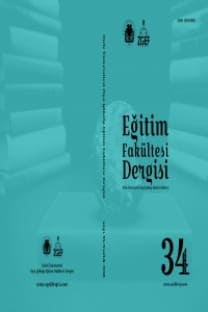CUMHURİYET-DİCLE-İNÖNÜ ÜNİVERSİTESİ EĞİTİM FAKÜLTESİ İLKÖĞRETİM BÖLÜMÜ ÖĞRENCİLERİNİN ÖĞRENME STİLLERİ ve ÖĞRENME STİLLERİNİ FARKLILAŞTIRAN SOSYO-EKONOMİK FAKTÖRLER
Bu çalışmanın amacı, Cumhuriyet, Dicle, İnönü Üniversitesi Eğitim Fakültesi İlköğretim Bölümlerinde okuyan öğrencilerin “Öğrenme Stillerini” belirlemektir. Araştırma için gerekli olan veriler, A.David Kolb tarafından geliştirilen “Öğrenme Stilleri Envanteri” ile toplanmıştır. Araştırmanın örneklemi 936 öğrenciden oluşmaktadır. Veriler “Varyans Analizi” (F) Testi, Tukey,LSD Testi ve (T) Testi kullanılarak analiz edilmiştir. Analiz sonucunda; Sınıf Öğretmenliği, İlköğretim Matematik Öğretmenliği, İlköğretim Fen Bilgisi Öğretmenliği, Sosyal Bilgiler ve Türkçe Öğretmenliği öğrencileri daha çok “Aktif Yaşantı” ve “Soyut Kavramsallaştırma” öğrenme biçimlerini benimsemişlerdir. Ayrıca bu öğrenciler, “Yerleştiren-Ayrıştıran”, ”Değiştiren-Özümseyen” öğrenme yeteneklerine sahiptirler. Öğrencilerin Öğrenme Stilleri ile öğrencilerin cinsiyetleri, öğrenci ailelerinin barındıkları yerler, öğrencilerin doğum yerleri, öğrencilerin barındıkları yerler, mezun oldukları okullar, babalarının gelir seviyesi, anne ve babalarının eğitim düzeyleri ve anne ve babalarının meslekleri arasında anlamlı farklılıklar bulunmuştur.
Anahtar Kelimeler:
Öğrenme Stilleri, Aktif Yaşantı, Soyut Kavramsallaştırma, Yerleştiren- Ayrıştıran, Özümseyen-Değiştiren, Kolb’un Yaşantısal Öğrenme Kuramı.
University Faculty of Education Inönü, Dicle and Cumhuriyet of Primary Learning Styles Students, Learning Styles and Different Makes of SocioEconomic Factors
The purpose of this study is to investigate the learning styles of the Cumhuriyet ,Dicle,Inönü Universty Education Faculty Primary Teaching students.The data for this study was collected by means of the “Learning Styles Inventory” who developed by A.David Kolb. The research sample is consisted of 936 students. The data were analyzed with variance, Tukey and LSD and (T) test.The results of the analysis showed that the students of primary teaching and social teaching and Turkish teaching and mathematics teaching and science teaching preferred active experience and abstract conceptualization. These students have “Accomodating-Covering” and “Diverging-Assimilating” learning styles. The learning styles of students showed meaningful differences with the sexuality of students ,the residence place of their family , the birth place of students, the residence place of students,the schools which they graduated, the level of income of their fathers,the professions of their fathers and mothers and the education level of their fathers and mothers.
Keywords:
Learning Styles, Active Experience, Abstract Conseptualization, Accomodating, Covering, Diverging,
___
- ASLAN B.-BABADOĞAN C. (2005). İlköğretim 7.8.Sınıf Öğrencilerinin Öğrenme Stillerinin Akademik Başarı Düzeyi, Cinsiyet ve Yaş İle İlişkisi” Eğitim Araştırmaları Dergisi, ,sayı.21,s.35-48
- AŞKAR.P.-AKKOYUNLU B. (1993),”Kolb’un Öğrenme Stili Envanteri”,Eğitim ve Bilim Dergisi, Cilt.17,s..37-47
- BOYDAK Alp(2006) Öğrenme Stilleri, İstanbul, Beyaz Yayınları, s.3.
- DİAZ David and RYAN.C.(1999)”Student’s Learning Styles In Two Classes” College Teaching, Vol.47(4),s.130-136
- FELDER.M.R. and HENRİQUES.R.E.(1995) Learning and Teaching Styles in Foreign and Second Language Education”Foreign Language Annuals,Volume 28(1),pp.21-31.
- HEİNİCH R., MOLENDA.M, RUSSEL.J.D and SMALDİNA.S.E(1996) Instructional Media and Technologies For Learning. Fifth Edition,New-Jersey,Printice Hall,inc,s.37
- JAMALİAH, A., DATOL Z., AKMALİAH L. P., RAHİL. M. (2006). ”Learner Learning Styles as a Response to Lecturer Factor:A Case Study Of Businness Studies In an Institution Of High Learning” Sam Sharpe Teachers College and Montego By Community College Thiteenth International Conference On Learning, Montego/Jamaica,s.80
- JAMES. W.B. and GABRAİTH. M.W,(1985)”Perceptual Learning Styles Implications and Techniques For The Practitioner” Lifelong Learning,Vol.8,Sayı.4,s.20
- KATZ .N and HEİMAN.N.(1991) “Learning Styles Of Students and PractitionarsIn Five Health Vol.11,Number.4,p.p.239-344 Occupational Therapy Journal Of Research
- KEEFE.J.W.-FERREL B.G. (1984)”Developing A Defensible Learning Style Paradigm” Educational Leadership, Vol.48(2),p,56-61
- KOLB, D.A. (1984) Experimental Learning.Experience as Source Of Learning and Development New-Jersey,Prentice Hall,s.39-41
- SUTLİFF. R and BALDWİN.V,(2001)”Learning Styles Teaching Technology Subjects Can Be More Effective”,The Journal Of Technology Studies, Winter-Spring, p.p.22- 27.htt//schoolar.lib.vt.edu/ejournals.
- WANG. K.H.,.WANGW. T.H, WANGZ. W.L. and HUANGZ. S.C., (2006)” Learning Styles And Formative Assesment Strategy:Enhancing Student Achivement In Web-Based Learning” Journal Compilation,Blackwel Publishing Ltd Journal Of Computer Assisted Learning, Sayı 22,p.207-217
- ISSN: 1305-0060
- Yayın Aralığı: Yılda 2 Sayı
- Başlangıç: 1995
- Yayıncı: Dicle Üniversitesi
Sayıdaki Diğer Makaleler
İLKÖĞRETİM ÖĞRETMENLERİNİN GÖRÜŞLERİNE GÖRE İLKÖĞRETİM DENETMENLERİNİN ETİK DAVRANIŞLARI
EĞİTİM DÜZEYİ AÇISINDAN TÜRKİYE İŞGÜCÜ YAPISINDAKİ DEĞİŞİMLER
UZAKTAN ÖĞRETİMİ TERCİH EDEN ÖĞRENCİLERİN DEMOGRAFİK ÖZELLİKLERİ
Meltem BATURAY, Ömer Faruk BAY
FEN VE TEKNOLOJİ DERSİ KONULARININ OKULDA ve DERSHANEDE İŞLENİŞİYLE İLGİLİ DURUMLARIN BELİRLENMESİ
Hakan Şevki AYVACI, Sibel Er NAS
ORTAÖĞRETİM 9. SINIF FİZİK DERS KİTABININ DERS KİTABI DEĞERLENDİRME ÖLÇÜTLERİNE GÖRE İNCELENMESİ
Cihat DEMİR, A. Kadir MASKAN, Şahika ÇEVİK, Medine BARAN
KOSOVA’DA TÜRKÇE EĞİTİM ve SINIF ÖĞRETMENİ YETİŞTİRME İHTİYACI
